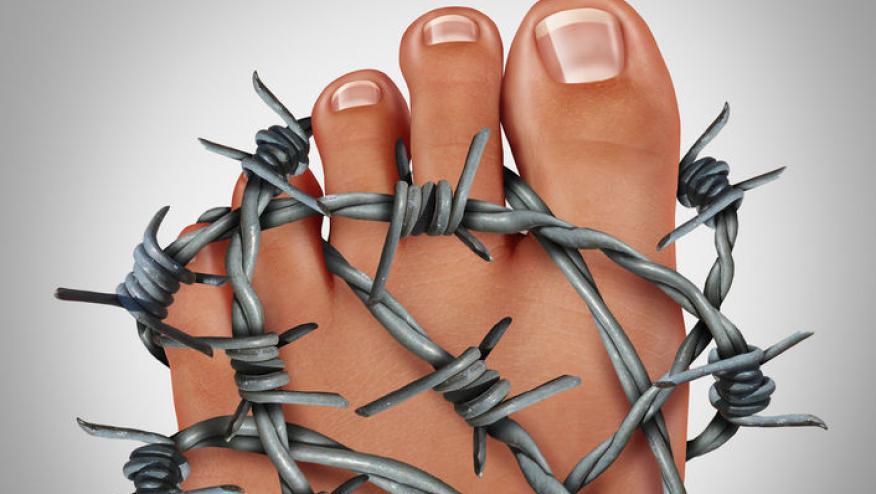Opioids Overused in Acute Gout Save

Opioids were commonly given to patients as a treatment for acute gout attacks, despite the availability of other effective and appropriate therapies, a retrospective study found.
Among 456 patients who were discharged from the hospital or emergency department (ED) with a primary diagnosis of gout, 28.3% received an opioid prescription, according to Deepan S. Dalal, MD, of Brown University Warren Alpert School of Medicine in East Providence, Rhode Island, and colleagues.
And while the median duration of the prescription was 8 days, one-quarter of these patients had prescriptions for 14 days or more, which exceeds gout attacks' normal expected length, the researchers reported in Arthritis Care & Research.
"The fact that 28% of patients are being treated with opioids, and many longer than 2 weeks, is alarming and provides an opportunity to reduce the burden of prescription opioids," Dalal said in a press release.
Gout is an inflammatory form of arthritis that has been estimated to afflict 4% of the population, and is associated with high levels of pain and disability. Recommended therapies include corticosteroids, nonsteroidal anti-inflammatory drugs, and colchicine, which are "very effective for reducing the inflammation and pain associated with the attack," the researchers wrote.
In contrast, opioids are not considered as having anti-inflammatory effects, yet anecdotal evidence has suggested they are often prescribed acute gout attacks.
Therefore, to examine the prevalence of opioid use, specific types used, and associated factors, Dalal and colleagues reviewed the health records of patients enrolled in the Rhode Island Lifespan Healthcare Systems from 2015 to 2017.
The 129 patients identified as having been discharged with an opioid prescription averaged age 58.7 years, and 79% were men. The most commonly used opioid was oxycodone or an oxycodone combination, seen in 81%. The average daily dose was 37.9 morphine mg equivalents.
Patients given opioids tended to be slightly younger (57.37 vs 59.27 years, P<0.05) and more often were men (85.3% vs 77%, P<0.05) than those not receiving opioids. They also more often had hypertension (85.1% vs 75.5%, P<0.05), diabetes (47.7% vs 32.2%, P<0.05), and a history of substance abuse (14% vs 6.9%, P<0.05).
There was no difference between the two groups in use of appropriate gout therapy, meaning steroids, nonsteroidals, or colchicine (83% vs 87.2%), a finding which was unexpected. Nor were there differences in systemic factors such as time of day or day of the week at discharge, or hospital or insurance type.
In a multivariable analysis, factors that were associated with having an opioid prescription at discharge were polyarticular gout (OR 2.435), diabetes (OR 2.041), and opioid use prior to admission (OR 2.141). In a sensitivity analysis excluding patients already on opioids, independent associations persisted for diabetes (OR 2.04, 95% CI 1.15-3.60) and polyarticular attack (OR 2.02, 95% CI 1.05-3.90).
The observation that patients receiving opioids more often had diabetes reflected the particular difficulty of managing the acute gout attack in this subgroup, given that the foot problems associated with diabetes can resemble classic podagra. In addition, standard gout treatments can lead to diabetic complications such as hyperglycemia following intra-articular steroid injections.
Dalal and colleagues concluded that there is a "large burden" of prescription opioid use among patients discharged with gout. They also noted that the frequent choice of oxycodone differs from patterns of opioid prescribing in Europe, where initial treatment more often is with tramadol or codeine. Use of oxycodone rather than less potent opioids "is reflective of [overall] clinical practice in the U.S.," the authors wrote.
Strategies for reducing opioid overuse in gout could include adding prompts to the electronic health record system about avoiding these drugs or recommending less powerful agents and shorter treatment duration.
"Increasing coordination of care between ED physicians and outpatient doctors could mitigate the fears of using conventional gout therapies by ED providers as well as reduce the risk of readmission to the ED, which could ultimately lead to less use of prescription opioids," Dalal and colleagues concluded.
Limitations of the study included its retrospective design and reliance on administrative data.
Primary Source









If you are a health practitioner, you may Login/Register to comment.
Due to the nature of these comment forums, only health practitioners are allowed to comment at this time.